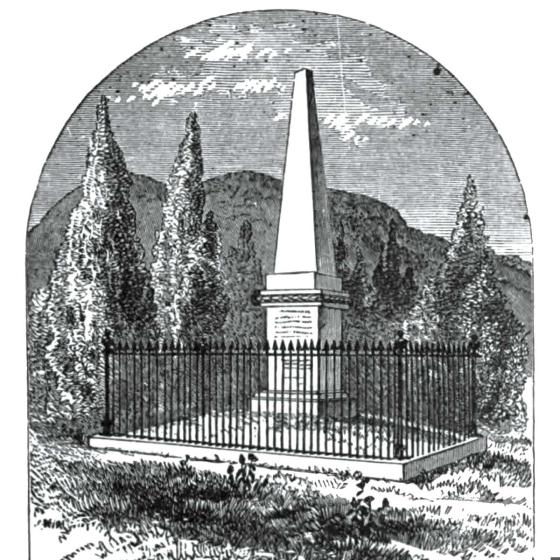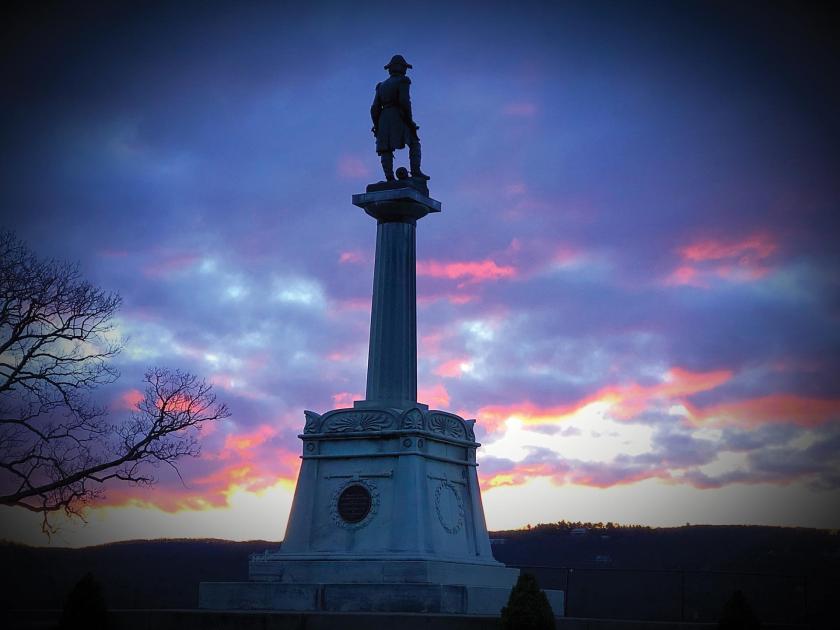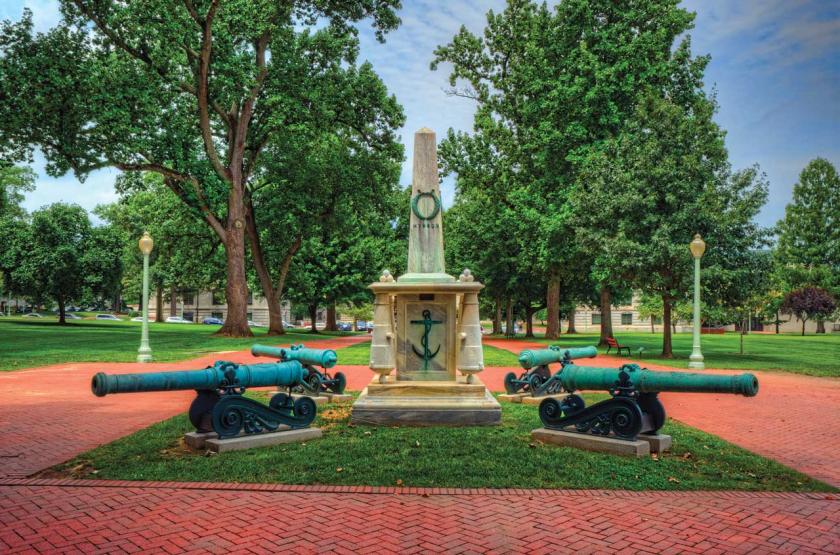A Scenery of Story-filled Stone

The "lucky spur" of the Sedgewick Monument at West Point.
As part of a series on military service academies, the American Battlefield Trust examines the history of some of the most inspiring monuments and statues at the The U.S. Military Academy at West Point, N.Y. and the The U.S. Naval Academy at Annapolis, Md.
Each day, cadets and midshipmen at the U.S. Military Academy and U.S. Naval Academy walk past reminders of those who laid the foundation on which they themselves strive to build their own legacies. Cast in stone, monuments and statues are the keepers of stories that have and continue to inspire our nation’s military leaders.
U.S. Military Academy at West Point

Wood’s Monument (1818)
The oldest monument at West Point, the four-sided obelisk Wood’s Monument honors Lieutenant Colonel Eleazar Derby Wood — an academy graduate and army engineer who died valiantly at the siege of Fort Erie during the War of 1812. At the conclusion of the war, Major General Jacob Brown ordered its construction at his own expense. Erected in 1818, the 15-foot monument now sits in the West Point cemetery. Wood was also memorialized through the naming of a star fort in New York Harbor, which now stands as part of the base for one of our nation’s ultimate symbols of freedom, the Statue of Liberty.

Kościuszko’s Monument (1828)
During the American Revolution, General Washington appointed Tadeusz Kościuszko as fortification engineer of West Point, and as such, he designed the defenses of the West Point garrison from 1778 to 1780. In 1825, John Latrobe — son of the famous Architect of the Capitol Benjamin Latrobe — proposed a monument be built on the campus to honor the “Patron Saint of West Point.” Dedicated in 1828, the monument became the second oldest in the world dedicated to the Polish general, with the first in Krakow, Poland. The statue element, designed by D. Borja, wasn’t added until 1913.

Sedgwick Monument (1868)
The first monument built to honor the West Point graduate and Union Corps Commander John Sedgwick, who fell at the Battle of Spotsylvania Court House, the Sedgwick Monument was sculpted by Launt Thompson. It was erected and dedicated in 1868 with the support of officers and soldiers from his last command, the 6th Army Corps. Legend has it that his statue was cast from Confederate cannons captured by them! Additionally, it is said to be a source of good luck for cadets struggling academically — if one spins the spurs on the Sedgwick’s boots.

Battle Monument (1897)
Standing tall upon the U.S. Military Academy campus at Trophy Point, the Battle Monument cannot easily be missed. Funded by the officers and soldiers of the Union Regular Army, the monument consists of a 46-foot-tall, polished granite column and surrounding cannons; the names of 2,230 Union officers and soldiers are inscribed throughout; and high atop, a statue of “Fame.” While the bulk of the monument was designed by Stanford White, the famed female statue was designed and sculpted by Frederick MacMonnies. Dedicated in 1897, it stands as a tribute to the Federals who fell in battle during the Civil War.
U.S. Naval Academy at Annapolis

Mexican War Midshipmen’s Monument (1848)
The first monument to be built upon the grounds of the Naval Academy, the Mexican War Midshipmen’s Monument is a marble obelisk that was created by sculptors R.A. Griffith and John Stephenson. Inscribed on each side are the names of four midshipmen — Clemson, Hynson, Pillsbury and Shubrick — who fell during the Battle of Veracruz in 1847. While none of these men stepped foot upon the campus grounds in Annapolis, their fellow midshipmen ensured their legacy would inspire generations of future attendees by gifting the structure in 1848.

Tripoli Monument (1860)
Honoring six naval officers killed in action during the little-known Barbary Wars of the early 1800s, the Tripoli Monument was carved in Italy by Giovanni C. Micali in 1806. It is the oldest military monument in the United States and features the allegorical figures America, History, Commerce and Victory. The monument is a reminder of the evolution of the U.S. Navy, as the Barbary Wars marked the first real test abroad for the young naval force. Originally erected in the Washington Navy Yard, the monument was later moved to the grounds of the U.S. Capitol, and in November 1860, it was transferred to its current home at the U.S. Naval Academy.

Tamanend Statue (1930)
Chief of the Delaware Indians, Tamanend envisioned a peaceful existence between Native tribes and European settlers. He even agreed to a series of treaties with William Penn to ensure peace “as long as the creeks and rivers flow and the sun, moon and stars endure.” More than a hundred years after his passing, Tamanend’s likeness was carved into wood by artist William Luke in 1817, and was used as the figurehead for the USS Delaware. While the ship was salvaged in 1866 and the wooden sculpture sent to the Naval Academy, it wasn’t until 1930 that the wooden carving was cast in bronze and placed on a pedestal facing Bancroft Hall. Today, midshipmen look to the statue with penny offerings and hopes of passing grades.

Commodore John Barry Memorial (2014)
Erected by the Ancient Order of the Hibernians and dedicated in 2014, the Commodore John Barry Memorial pays tribute to “The Father of the American Navy.” After offering his services to Washington and the Continental Congress, Captain Barry was given command of the Lexington in December 1775. Throughout the course of the Revolution, Barry captained three ships and delivered the first successful Patriot naval win with the defeat of the HMS Edward. The young memorial sits upon the Barry Plaza, which can be accessed through the Barry Gate on the U.S. Naval Academy campus.


